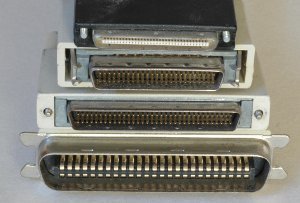SCSI (Small Computer System Interface)
SCSI (Small Computer System Interface) is a set of ANSI standards for connecting devices to computer systems. The vast majority of SCSI devices are data storage devices.
Standard SCSI is a parallel technology, but many serial SCSI variants exist, including FireWire and Fibre Channel.
SCSI is generally considered a higher-end alternative to IDE (Integrated Drive Electronics). A single IDE controller can control two drives. A single SCI controller can control 8 or 16 drives. In addition, SCSI usually offers greater cable length and higher length than IDE.
SCSI Standards
SCSI Standard Cable Length Speed (MBps) Devices Supported SCSI-1 6 5 8 SCSI-2 6 5-10 8 or 16 Fast SCSI-2 3 10-20 8 Wide SCSI-2 3 20 16 Fast Wide SCSI-2 3 20 16 Ultra SCSI-3,8-bit 1.5 20 8 Ultra SCSI-3,16-bit 1.5 40 16 Ultra-2 SCSI 12 40 8 Wide Ultra-2 SCSI 12 80 16 Ultra-3 (Ultra160/m) SCSI 12 160 16
Narrow and Wide SCSI
Many SCSI standards have options for Narrow or Wide operation. Narrow SCSI is parallel SCSI which transmits 8 bits of data at a time. Wide SCSI is parallel SCI which transmits 16 bits of data at a time.


Comments - No Responses to “SCSI (Small Computer System Interface)”
Sorry but comments are closed at this time.